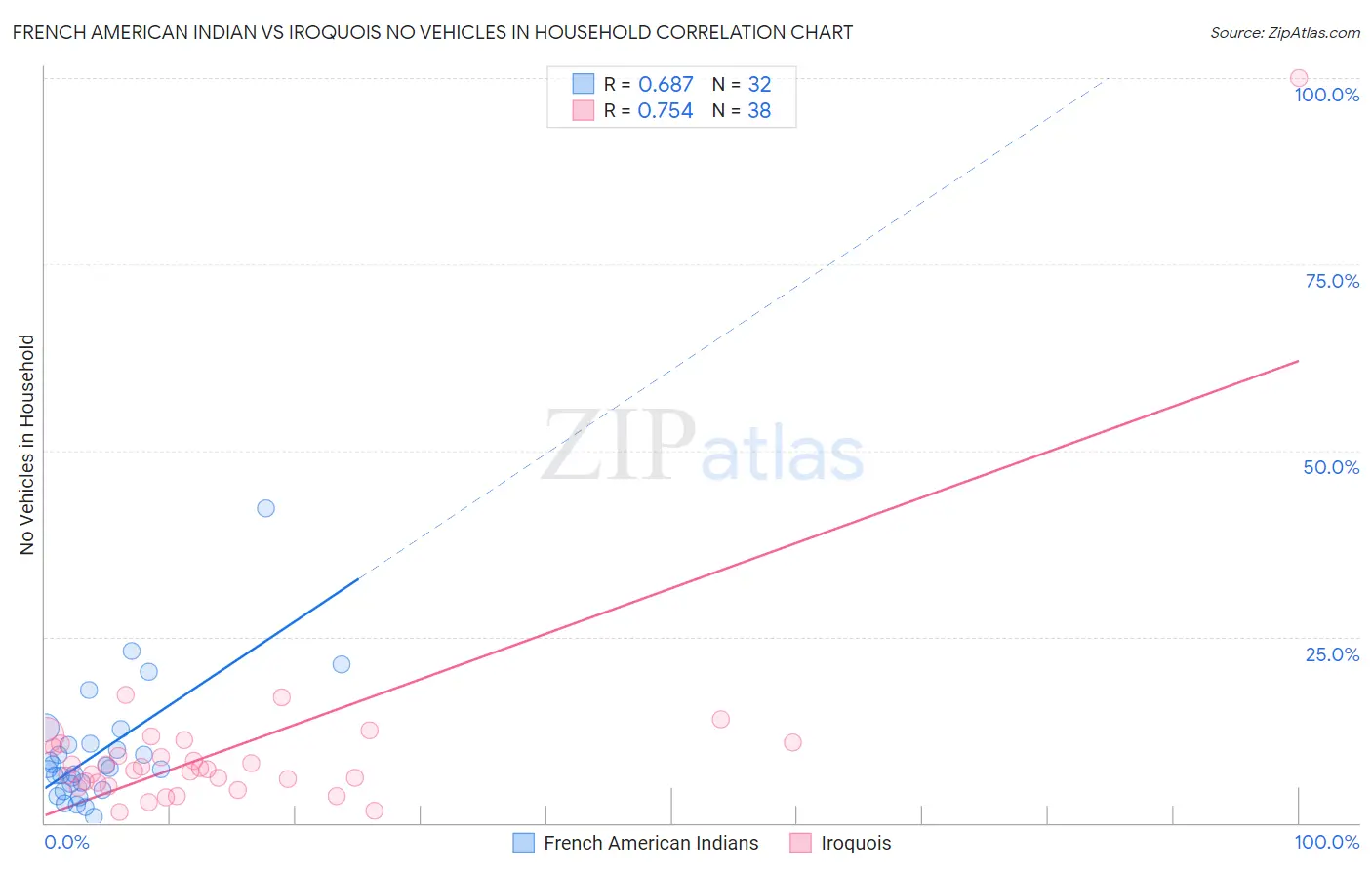French American Indian vs Iroquois No Vehicles in Household
COMPARE
French American Indian
Iroquois
No Vehicles in Household
No Vehicles in Household Comparison
French American Indians
Iroquois
10.4%
NO VEHICLES IN HOUSEHOLD
49.1/ 100
METRIC RATING
176th/ 347
METRIC RANK
10.9%
NO VEHICLES IN HOUSEHOLD
17.6/ 100
METRIC RATING
203rd/ 347
METRIC RANK
French American Indian vs Iroquois No Vehicles in Household Correlation Chart
The statistical analysis conducted on geographies consisting of 131,848,748 people shows a significant positive correlation between the proportion of French American Indians and percentage of households with no vehicle available in the United States with a correlation coefficient (R) of 0.687 and weighted average of 10.4%. Similarly, the statistical analysis conducted on geographies consisting of 206,994,531 people shows a strong positive correlation between the proportion of Iroquois and percentage of households with no vehicle available in the United States with a correlation coefficient (R) of 0.754 and weighted average of 10.9%, a difference of 5.1%.

No Vehicles in Household Correlation Summary
| Measurement | French American Indian | Iroquois |
| Minimum | 0.86% | 1.5% |
| Maximum | 42.3% | 100.0% |
| Range | 41.4% | 98.5% |
| Mean | 9.5% | 10.1% |
| Median | 7.3% | 7.3% |
| Interquartile 25% (IQ1) | 4.9% | 5.5% |
| Interquartile 75% (IQ3) | 10.6% | 10.7% |
| Interquartile Range (IQR) | 5.7% | 5.2% |
| Standard Deviation (Sample) | 8.1% | 15.4% |
| Standard Deviation (Population) | 8.0% | 15.2% |
Similar Demographics by No Vehicles in Household
Demographics Similar to French American Indians by No Vehicles in Household
In terms of no vehicles in household, the demographic groups most similar to French American Indians are Immigrants from Burma/Myanmar (10.4%, a difference of 0.0%), Immigrants from El Salvador (10.4%, a difference of 0.010%), Immigrants from Sudan (10.4%, a difference of 0.12%), Filipino (10.4%, a difference of 0.13%), and Immigrants from Ethiopia (10.4%, a difference of 0.16%).
| Demographics | Rating | Rank | No Vehicles in Household |
| Lumbee | 54.7 /100 | #169 | Average 10.3% |
| Immigrants | Latin America | 53.2 /100 | #170 | Average 10.4% |
| Hmong | 52.7 /100 | #171 | Average 10.4% |
| Brazilians | 51.7 /100 | #172 | Average 10.4% |
| Filipinos | 50.1 /100 | #173 | Average 10.4% |
| Immigrants | Sudan | 50.0 /100 | #174 | Average 10.4% |
| Immigrants | Burma/Myanmar | 49.1 /100 | #175 | Average 10.4% |
| French American Indians | 49.1 /100 | #176 | Average 10.4% |
| Immigrants | El Salvador | 49.1 /100 | #177 | Average 10.4% |
| Immigrants | Ethiopia | 48.0 /100 | #178 | Average 10.4% |
| Ethiopians | 45.8 /100 | #179 | Average 10.5% |
| Arabs | 45.3 /100 | #180 | Average 10.5% |
| Immigrants | Colombia | 44.1 /100 | #181 | Average 10.5% |
| Immigrants | Bulgaria | 43.8 /100 | #182 | Average 10.5% |
| Natives/Alaskans | 43.7 /100 | #183 | Average 10.5% |
Demographics Similar to Iroquois by No Vehicles in Household
In terms of no vehicles in household, the demographic groups most similar to Iroquois are Romanian (10.9%, a difference of 0.070%), Immigrants from Western Europe (10.9%, a difference of 0.34%), Guatemalan (11.0%, a difference of 0.34%), Immigrants from Chile (11.0%, a difference of 0.38%), and Somali (11.0%, a difference of 0.39%).
| Demographics | Rating | Rank | No Vehicles in Household |
| Central Americans | 24.3 /100 | #196 | Fair 10.8% |
| Shoshone | 24.1 /100 | #197 | Fair 10.8% |
| Immigrants | Sweden | 22.9 /100 | #198 | Fair 10.8% |
| Immigrants | Asia | 21.3 /100 | #199 | Fair 10.9% |
| Cambodians | 19.6 /100 | #200 | Poor 10.9% |
| Immigrants | Western Europe | 19.1 /100 | #201 | Poor 10.9% |
| Romanians | 17.9 /100 | #202 | Poor 10.9% |
| Iroquois | 17.6 /100 | #203 | Poor 10.9% |
| Guatemalans | 16.1 /100 | #204 | Poor 11.0% |
| Immigrants | Chile | 15.9 /100 | #205 | Poor 11.0% |
| Somalis | 15.9 /100 | #206 | Poor 11.0% |
| Sierra Leoneans | 15.7 /100 | #207 | Poor 11.0% |
| Immigrants | Italy | 15.6 /100 | #208 | Poor 11.0% |
| Pennsylvania Germans | 15.5 /100 | #209 | Poor 11.0% |
| Apache | 14.8 /100 | #210 | Poor 11.0% |